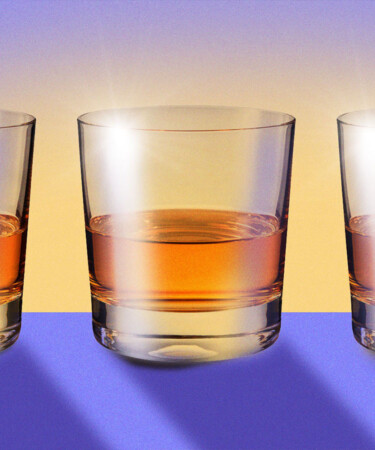As with many aged spirits, with a bottle of bourbon, you can never be completely sure what you’re going to get. That’s why it’s important to do this one thing first before you pour a full glass or mix up a cocktail.
As bourbon continues to rise in popularity and attract more drinkers to the category, it feels necessary to revisit the basics. If we were to distill our knowledge down to one piece of advice on how to optimize your bourbon experience — especially when enjoying a new brand or expression — it’s to properly sample the bottle before serving it.
Why? Even though bourbon is held to specific production standards, different bottles can still vary in strength, sweetness, flavor, and intensity. While bourbon has to be a minimum of 80 proof (or 40 percent alcohol) by law, bottles can range from 80 to 100 proof or higher, leaving a lot of room for variation. Other factors that can contribute to the liquid’s characteristics include the mash bill, the type of cask it was matured in, and the age of the bourbon itself. All of these complex factors are what make it essential to sample your bourbon, as you can never be completely sure what you’re going to get.
What you learn from this initial sampling can also help you decide which format will bring out the best in your bourbon. While many bourbon drinkers have their own personal preference regardless of what bottle they’re drinking — purists tend to prefer drinking the beverage neat, but it can also be served on the rocks, diluted with water, or used in a cocktail — many bottles can benefit from being served in a specific way. So, when it is time to decide which format suits the bourbon in question best, the key is simply to taste it first.
So, what is the best way to sample your bourbon? Booker Noe, the late master distiller for Jim Beam, coined the term “Kentucky chew” to describe the perfect tasting technique. The Whiskey Wash describes the method on its website:
“Hold the whiskey up to the light and observe things like color and legs. Then, place your nose into the glass with your lips parted and breathe through your mouth to smell the whiskey without burning your nose with alcohol vapors. Next, sip the whiskey, swishing it all around your mouth and smacking your lips together after your swallow.” This strategy will allow you to properly assess all of the intricacies your bourbon has to offer.
If you sample a bourbon and find it to have a manageable strength or delicate flavors that you would want to preserve, consider serving it neat to maintain its integrity. If you find that your selection is a little intense for your taste, then you can try adding a few drops of water or serve it on the rocks to mellow it out. When it comes to diluting your bourbon, sampling it can also help determine exactly how much — or how little — you should water it down.
If you are planning on making a cocktail, certain characteristics of the bourbon can be amplified or balanced by the supporting ingredients you choose. For example, if your bourbon is registering on the sweeter side, you can embrace that flavor profile by incorporating it into a Gold Rush or a Whiskey Sour. If you taste a bourbon with interesting, complex flavors and you want to make a spirit-forward cocktail to showcase it, we recommend a classic Old Fashioned.
So instead of diving right in the next time you open up a bottle of bourbon, take a moment to sample and reflect on the liquid first — it can really help enhance your bourbon experience.
